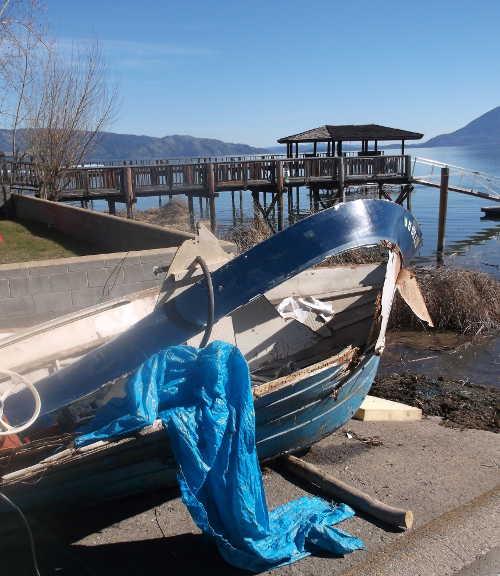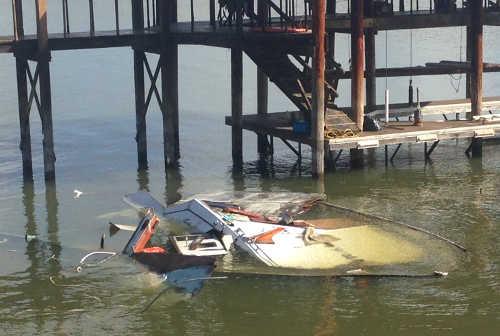- Elizabeth Larson
- Posted On
Judge denies mistrial motion in 2013 Clearlake Oaks home invasion case
LAKEPORT, Calif. – On Thursday a visiting judge denied a defense motion seeking a dismissal or mistrial in the case of two men on trial for a June 2013 home invasion and shooting.
Attorney Bill Conwell filed the motion on behalf of his client, Dion Davis II, with attorney Doug Ferguson joining the action on behalf of his client, Gregory Elarms, Davis' half-brother and co-defendant.
Conwell alleged that prosecutorial misconduct has taken place, and that discovery evidence has been released to the defense late or, in some cases, not at all, and in other instances had been destroyed.
District Attorney Don Anderson, who is prosecuting the case with Deputy District Attorney Daniel Flesch as his co-counsel, successfully argued that case discovery was produced in a timely manner, and one document that was produced late – specifically, a detective's report – wasn't relevant to the two defendants.
The trial of Davis, 27, and Elarms, 30, both of San Francisco, began at the end of January.
Davis and Elarms are alleged to have been among five suspects involved in the June 26, 2013, home invasion robbery at the Clearlake Oaks residence of Ronnie and Janeane Bogner, during which the Bogners' adult son, Jacob, was shot in the leg and pistol-whipped.
Davis, who is alleged to have been the shooter, is charged with attempted murder. Both he and his brother are charged with robbery, burglary, assault with a firearm on Jacob Bogner and on Lt. Tim Celli of the Clearlake Police Department, car theft, theft, vandalism and conspiracy.
Retired Placer County Judge James Garbolino – who is presiding at trial due to the local judges recusing themselves because they know the Bogners – held a Thursday afternoon hearing to consider Conwell's motion as well as Anderson's response.
At the start of the hearing – which took place after the jury had been dismissed for the day – Garbolino briefly convened the matter before going into a private – or “in camera” – hearing with sheriff's office personnel and Deputy County Counsel Lloyd Guintivano.
The in camera hearing was to discuss matters related to a defense Pitchess motion – which seeks access to a law enforcement officer's personnel records – regarding sheriff's Det. Doug Dahmen, who had been the lead detective on the case.
The hearing also considered inquiries related to Brady v. Maryland, a US Supreme Court case that requires any potentially exculpatory evidence – including the performance of a law enforcement officer – be turned over to criminal defendants. That includes information in personnel records that could be impeaching.
During testimony at the start of the trial, Dahmen testified to failing to follow up on potentially exculpatory evidence for San Franciscan Dexter Currington, who had been arrested as the case's fifth suspect in September 2013.
He was eventually released in March 2014 after the District Attorney's Office determined he was not involved.
While the in camera discussion was taking place in the jury room, it was discovered that in the courtroom Davis and Elarms – sitting at the defense table – were able to see the content of the discussion through a connection between Conwell's computer and that of the court reporter, which is a service offered during the trial proceedings.
At one point the court reporter emerged from the jury room and took Conwell's computer temporarily.
When Garbolino and the group returned from the discussion, he ruled that he was not releasing the information from the discussion, as he didn't find it justified.
He explained the matter of the proceedings being broadcast to Conwell's computer and seen by the defendants, and ordered that the information not be reproduced, transmitted or communicated to any other person.
Garbolino then moved to the matter of Conwell's dismissal motion and the alleged discovery violations.
In his motion, Conwell had raised issues with a number of discovery items, among them, an interview conducted with Jacob Bogner by the Chico Police Department shortly after the shooting, done as a courtesy, as Bogner had been transported to Enloe Hospital in Chico for treatment. Conwell said it was provided to the defense in October after having been requested in June.
Anderson's written motion noted the Chico Police interview was given to the defense in February 2014, and a second copy was delivered in October.
The defense also requested in July discovery related to firearm tool mark evidence. Anderson said the information was from the notes of a Department of Justice expert that hadn't been sent to the District Attorney's Office. The notes were provided to the defense on Feb. 5, the day the expert testified at trial.
There also were requests for a recording of an interview with Janeane Bogner that Dahmen conducted on July 2, 2013, which Anderson said he's not sure ever existed; a jailhouse interview Dahmen had with Currington on Sept. 28, 2013, sent to defense in June; and a report about two other defendants in the home invasion – Sean Foss and Tyler Gallon – in which Gallon is alleged to have encouraged other Lake County Jail inmates to intimidate Foss, provided in January.
The defense motion also mentioned a possible Brady investigation by Anderson's office into the truthfulness of Dahmen's statements on the stand earlier in the trial.
Anderson said no such investigation was done as of Jan. 13, although a preliminary review of the information available caused him to conclude that he could not find there was “substantial evidence” that Dahmen lied, “versus being incompetent.”
Judge, defense questions detective
Garbolino called Dahmen – accompanied to his attorney, Manuel Nieto – to the stand, at which point Garbolino himself asked Dahmen a number of questions about the items of discovery evidence cited in Conwell's action.
He asked Dahmen about the Janeane Bogner interview, and if it had been recorded. Dahmen said he did a report about it, but his report doesn't say that he recorded the session.
It was during that interview that Bogner identified Currington in a photo lineup. He subsequently was arrested.
Garbolino asked Dahmen about alibi evidence Currington had given him during the jailhouse interview. Dahmen said Currington stated he had been helping a friend move. He also gave Dahmen phone numbers of people to call to back up his alibi.
However, Dahmen didn't call those individuals. Garbolino asked why he didn't.
“I can't recall why I did not,” said Dahmen. “I didn't conduct any further followup.”
When Garbolino asked a series of other questions about alibi contacts and interaction with the District Attorney's Office over the case, Dahmen repeatedly responded, “I can't recall.”
Garbolino asked Dahmen why it took him six months to submit a report on his jailhouse interview with Currington. “I can't give you an excuse,” Dahmen said.
During his questioning of Dahmen, Conwell asked about Dahmen receiving the Chico Police report and the recording of the Janeane Bogner interview. Dahmen said he didn't recall receiving the report and didn't know what happened with the Bogner interview.
Ferguson asked Dahmen if he recalled showing Bogner a photo lineup and doing “anything improper.” Dahmen said he didn't remember.
Anderson had no questions for Dahmen.
In his arguments to the court, Conwell raised issues about a “seriously tainted identification process” in the case, emphasizing that the case is built on eyewitness identification, which was why the matters about Dahmen's interviews are so important.
Conwell said it wasn't Anderson who he was alleging was hiding discovery, it was the prosecution team, adding that case law is very clear that the prosecution team includes law enforcement. There are many cases, he added, that support the idea that Dahmen is part of Anderson's prosecution team.
He also raised concerns about an incident in which Gallon's father was alleged to have threatened Foss in jail. Due to the failure of making a timely report, video of that threat was lost, since the sheriff's office only keeps it for a specific amount of time, Conwell said.
He said there were several instances of the same officer – Dahmen – interfering with the investigative process. “That is evidence that the police were not acting in their role of investigators,” Conwell said.
Conwell said the jury needs to have the information – at least in the form of a jury instruction – that proper procedures weren't followed.
Anderson said it still hasn't been determined if Dahmen actually recorded the July 2013 interview with Janeane Bogner. If it had been recorded, Anderson said it would only show irregularities regarding the handling of Currington, and wouldn't be relevant to Davis.
He maintained there were no discovery violations. “As soon as we get the information, we turn it over to the defense.”
Anderson said some aspects of the case were not handled properly by the sheriff's office, which he acknowledged is part of the prosecution team. However, he said those particular aspects involved Currington, not Davis and Elarms.
Conwell replied that the issues he had with the prosecution could undermine confidence in the verdict. “This is a trial that has been infected by misconduct by the police,” he said, which was why he called an eyewitness expert.
Garbolino said he was not convinced that the recording of the Janeane Bogner interview actually existed, although there are indications that it did. The threats against Foss also can't be tied to the case.
He denied the requests for dismissal and mistrial. If the defense wanted to propose a special jury instruction, Garbolino said he would be sure to review it to ensure it accurately reflected any delays or faults.
The defense will continue presenting its case on Friday afternoon, and is expected to wrap up in time for closing arguments to take place at the end of next week.
Email Elizabeth Larson at This email address is being protected from spambots. You need JavaScript enabled to view it. . Follow her on Twitter, @ERLarson, or Lake County News, @LakeCoNews.











